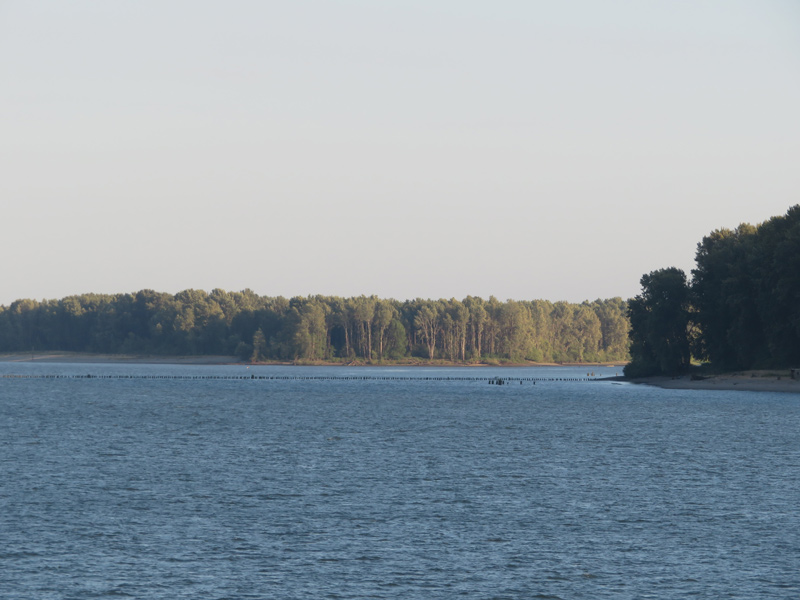The expedition passes Skilloot and Cowlitz River villages where some generous Skilloots give away food with hopes that the expedition hunters will hunt with them. Instead, two canoes are sent ahead to hunt on Deer Island below present St. Helens, Oregon. Lewis describes the area’s trees and prepares a specimen of salmonberry (Rubus spectabilis).
The Skilloots
by Yellowstone Public Radio[1]Originally aired weekdays by Yellowstone Public Radio during the Bicentennial observance of 2003-2006. Narrated by Hal Hansen. Scripts by Whit Hansen and Ed Jacobson. Produced by Leni Holliman. © … Continue reading
Generous Skilloots
the principal village of these Skillutes [Skilloots] reside on the lower side of the Cow-e-lis’-kee river a few miles from it’s entrance into the columbia. these people are said to be numerous. in their dress, habits, manners and language they differ but little from the Clatsops Chinnooks &c. they have latterly been at war with Chinnooks [Chinooks] but peace is said now to be restored between them, but their intercourse is not yet resumed. no Chinnooks come above the marshey islands nor do the Skillutes visit the mouth of the Columbia. the Clatsops, Cathlahmahs [Kathlamets] and Wackkiacums [Wahkiakums] are the carriers between these nations being in alliance with both.—
—Meriwether Lewis
Cowlitz River Villages
above the Skillutes on this river another nation by the name of the Hul-loo-et-tell [Cowlitz] reside, who are said also to be numerous.
—William Clark
Hospitable Natives
The natives appeared extreemly hospitable, gave us dryed Anchovies, Sturgeon, wappetoe, quamash, and a speceis of small white tuberous roots about 2 inches in length and as thick as a man’s finger; these are eaten raw, are crisp, milkey, and agreeably flavored. most of the party were served by the natives with as much as they could eat;
—Meriwether Lewis
Hunters Sent Ahead
we sent on Gibson’s canoe and Drewyers with orders to proceed as fast as they could to Deer island and there to hunt and wait our arrival. we wish to halt at that place to repair our canoes if possible.
—Meriwether Lewis
Salmonberry Blossom
Rubus spectabilis
Sandy River delta, 26 March 2012. © by Kristopher K. Townsend. Permission to use granted under the Creative Commons Attribution-Share Alike 4.0 International license.
Coastal Trees
saw the Cottonwood, sweet willow, oak, ash and the broad leafed ash, the growth which resembles the beach &c. these form the growth of the bottom lands while the hills are covered almost exclusively with the various species of fir heretofore described
—Meriwether Lewis
Salmonberry Specimen
we had scarcely landed before we were visited by a large canoe with eight men; from them we obtained a dryed fruit which resembled the raspburry and which I beeive to be the fruit of the large leafed thorn frequently mentioned. it is reather ascid tho’ pleasently flavored. I preserved a specemine of this fruit I fear that it has been baked in the process of drying and if so the seed will not vegitate.
—Meriwether Lewis
Weather Diary
Aspect of the weather at Rise
Wind at rise
Aspect of weather at 4 O’Ck P. M. Wind at 4 OCk. P. M. rain after clouds S. E. rain after clouds & rain S. E. blew hard about noon. rained greater part of the day. the small or bank martin appeared today, saw one large flock of them. waterfowl very scarce, a few Comorant, geese, and the redheaded fishing duck are all that are to be seen. the red flowering currant are in blume, this I take to be the same species I first saw in the Rocky Mountains; the fruit is a deep purple berry covered with a gummy substance and not agreeably flavoured. there is another speceis uncovered with gum which I first found on the waters of the Columbia about the 12th of August last.
—Meriwether Lewis[2]To assist the reader, the editor of this web page has omitted the “Day of the Month” column and spelled out some abbreviations.
Experience the Lewis and Clark Trail
The Lewis and Clark Trail Experience—our sister site at lewisandclark.travel—connects the world to people and places on the Lewis and Clark Trail.
Plan a trip related to March 27, 1806:

Notes
| ↑1 | Originally aired weekdays by Yellowstone Public Radio during the Bicentennial observance of 2003-2006. Narrated by Hal Hansen. Scripts by Whit Hansen and Ed Jacobson. Produced by Leni Holliman. © 2003 by Yellowstone Public Radio. |
|---|---|
| ↑2 | To assist the reader, the editor of this web page has omitted the “Day of the Month” column and spelled out some abbreviations. |


